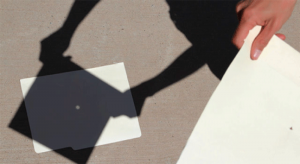
View the eclipse safely! Find out how at eclipse2017.nasa.gov/safety
So, unless you’ve been living under a moon rock, you know that this Monday the United States will be experiencing a very rare type of solar eclipse.
Here in the St. Michael–Albertville area, we will have the opportunity to see a partial eclipse, meaning that about 83% of the sun’s light will be covered by the moon at the peak of the event. The eclipse will be visible from 11:45 to 2:30, with the maximum eclipse taking place at 1:05 p.m.
If you want to see what the eclipse will look like from STMA,
check out the animation at timeanddate.com/eclipse/in/@z-us-55376.
Here’s a fun little video from McGraw-Hill Education you can use to teach your kids about the eclipse:
Remember! The ONLY safe way to look directly at the sun during an eclipse is through special AAS-approved eclipse glasses. More tips on viewing the solar eclipse safely >>
 If you weren’t one of the forward-thinking folks who picked up a pair of eclipse glasses (we weren’t—oops!), NASA has a great little video tutorial on how to create an eclipse viewer from a cereal box: Click here to view OR, the quick-and-easy method is to simply poke a hole in a piece of paper and let the sun shine through it to give you a tiny projected image of the sun’s light. >>
If you weren’t one of the forward-thinking folks who picked up a pair of eclipse glasses (we weren’t—oops!), NASA has a great little video tutorial on how to create an eclipse viewer from a cereal box: Click here to view OR, the quick-and-easy method is to simply poke a hole in a piece of paper and let the sun shine through it to give you a tiny projected image of the sun’s light. >>
Here are a few places to view the eclipse other than your own backyard:
Eclipse Viewing Parties:
- Hennepin County Libraries will be hosting viewing parties, where a limited supply of eclipse glasses will be provided. The nearest locations are Maple Grove and Brooklyn Park. (more info)
- The Bell Museum’s professional astronomers will be on hand at Southdale Library in Edina with special telescopes and a limited supply of eclipse-viewing glasses. A variety of STEM activities will also be available for guests. (more info)
- Science Museum of Minnesota will provide eclipse glasses for members and paid guests to view the eclipse on its outdoor terrace. Eclipse-themed activities and crafts will also be available. This could be a great day to visit the museum! (more info)
- Take a mini-roadtrip to Afton State Park. Make a solar eclipse viewer while supplies last, and learn how eclipses happen. Bring your own lunch or buy one from a food truck. (more info)
View on TV/Online:
- Many TV stations will have live broadcasts covering the events of the eclipse.
- NASA will be streaming video at nasa.gov with images from NASA spacecraft, aircraft, more than 50 high-altitude balloons, and the astronauts aboard the International Space Station—each offering a unique vantage point for the celestial event. (more info and link to view during event)
And if you REALLY want to see the TOTAL eclipse… Take a spontaneous road trip to the nearest city in which you can view the full solar eclipse—Lincoln, Nebraska, a mere 7-hour drive from STMA. Keep in mind that, even here, the sun will only be seen fully eclipsed for about 90 seconds. 😉
One more thing: Keep in mind that if you can’t find your ideal circumstances to see the eclipse this around, the next eclipse of this type will be visible in the U.S. in 7 years, the spring of 2024. Your kids may or may not still be kids then, but at least it will be within our lifetimes. 😀
Pinhole projector image via NASA Jet Propulsion Laboratory
Save
Save
Save
Save
Save
Save
Save
Related Posts
St. Michael Daze & Knights Festival (2021)
The St. Michael Daze & Knights Festival is coming up August 13 & 14, with…
20 August, 2017Family Fun at Albertville Friendly City Days (2021)
The Albertville Friendly City Days festival is almost here! My family loves when the carnival…
20 August, 2017